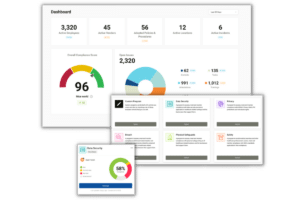
Many physical therapy practices are under the false assumption that they don’t need to comply with regulatory standards such as HIPAA, often discussing patient care in front of other patients. However, failing to follow healthcare compliance standards can harm your patients and your practice. Physical therapy (PT) compliance requires you to follow HIPAA, OSHA, and FWA, among other regulatory standards.
Is a Physical Therapy Compliance Manual Effective?
A lot of healthcare practices rely on compliance manuals to manage their compliance program. However, there are drawbacks to using a compliance manual. Physical therapy compliance manuals are a good start, but they’re often not reviewed and updated frequently enough.
There can be changes in the law or in the way your business operates that affect your compliance program. In these instances, you need to conduct a new risk assessment, and your training, policies, and procedures must be updated.
So, is a physical therapy compliance manual effective? No, it’s not.
What is an Effective PT Compliance Program?
An effective PT compliance program is updated and reviewed at least annually. The Office of Inspector General (OIG) released a General Compliance Program Guidance (GCPG) on an effective compliance program and how it can be implemented.
The following seven elements make up an effective compliance program.
- Written policies and procedures
- Compliance leadership and oversight
- Training and education
- Effective lines of communication with the Compliance Officer and disclosure program
- Enforcing standards with consequences and incentives
- Risk assessment, auditing, and monitoring
- Responding to detected offenses and developing corrective action initiatives
Written Policies and Procedures
In healthcare, policies and procedures are essential for several reasons. They ensure that patient information is handled correctly and secured, help to create a safe work environment for employees while protecting patients, and ensure ethical billing practices by preventing fraud, waste, and abuse.
Compliance Leadership and Oversight
Compliance leadership and oversight, through the designation of a Compliance Officer and Compliance Committee, ensures that your organization follows policies, procedures, and standards of conduct. They are also responsible for handling responses to reported breaches or incidents, and implementing corrective actions.
Training and Education
All healthcare employees must receive compliance training. Without effective training, your organization is vulnerable to breaches and incidents, and staff and patients could experience an injury or illness that would otherwise have been prevented.
Effective Lines of Communication with the Compliance Officer and Disclosure Program
Effectively communicating compliance obligations to staff members is essential. The OIG promotes transparency to ensure employees can confidentially communicate compliance concerns to authority figures. Effective communication also ensures that employees are aware of safety expectations, reporting procedures, and that a mechanism exists to report deviations in safety and compliance confidentially.
Enforcing Standards: Consequences and Incentives
Employees must be aware of the consequences of failing to follow compliance guidelines. Without well-publicized disciplinary guidelines, enforcing compliance can be difficult and lead to unequal treatment of employees should a violation occur.
Risk Assessment, Auditing, and Monitoring
Risk assessments, auditing, and monitoring of compliance efforts are significant in compliance. Risk assessments and auditing identify where your policies, procedures, or standards of conduct are lacking. Monitoring compliance efforts also ensures that your ongoing compliance efforts are effective.
Responding to Detected Offenses and Developing Corrective Action Initiatives
There are standards for reporting and responding to compliance incidents. Under HIPAA, breaches of patient information must be reported promptly. Breaches compromising patient information must be reported to the Department of Health and Human Services (HHS) and affected patients. Workplace injuries and illnesses must be reported to OSHA, and some must be reported immediately.
Fraud, waste, and abuse must also be reported to HHS. When organizations fail to meet ethical billing practices, fines can be costly and can lead to being added to the OIG exclusion list.
The Benefits of Using Physical Therapy Compliance Software
With everything that goes into PT compliance, it may seem impossible to implement an effective program. This is where physical therapy compliance software comes in. Compliance software allows you to track and manage your program in a single platform.
With Compliancy Group’s healthcare compliance software, you can easily access all of your compliance tasks, including policies, procedures, training, and risk assessments. Your standards can be enforced through employee attestations, which are also stored within the software platform. You can also report and track incidents to ensure compliance with reporting standards.
You no longer have to worry about your physical therapy compliance program being outdated. The software is updated whenever there is a change in the regulation, automatically issuing new policies, procedures, and training, and prompting you to conduct a risk assessment when necessary.









